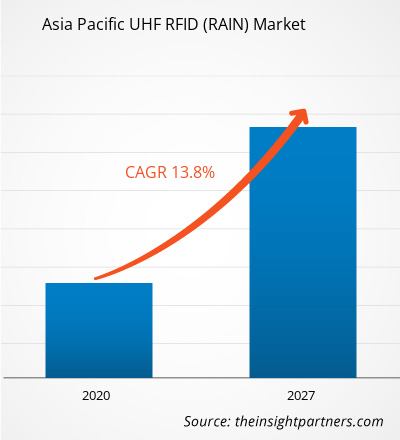The UHF RFID (RAIN) market in APAC is expected to grow from US$ 423.37 million in 2019 to US$ 1,178.78 million by 2027; it is estimated to grow at a CAGR of 13.8% from 2020 to 2027.
New opportunities being created due to developments in IoT is the major factor driving the APAC UHF RFID (RAIN) market. The adoption of smart devices and mounting government investments especially in countries such as Japan, Singapore, China, and Australia—focused on the R&D and installations of Internet of Things (IoT) in the manufacturing, utilities, retail, and other sectors is fueling the growth of IoT. It confers various objects with the ability to interconnect and share data. IoT applications necessitate a data connection between the physical and digital world, and UHF RFID is the finest technology to bridge these spaces. With the boom in IoT in various countries, most networked objects would be connected wirelessly through the passive UHF RFID technology that seamlessly allows passive objects to communicate crucial data, which can be used to identify these objects with exact place and time details. The technology adds intelligence to the IoT ecosystem and simplifies new applications for connected resources.As per RAIN RFID, in 2015, the technology connected~20 billion things, tracking the identity and authenticity of items. In addition, the implementation of UHF RFID increased by ~29% CAGR in healthcare, retail apparel, pharmaceutical, supply chain, and logistics industries. Further, as per IWEC Foundation, there will be ~64 billion IoT devices by 2025, which is up from ~10 billion in 2018. Thus, being a crucial building block of the IoT, the UHF RFID technology will allow several new applications and business models, along with making them affordable and practical for users.
APAC is characterized by many developing countries, a positive economic outlook, high industrial presence, huge population, and rising disposable income. All these factors make APAC a major growth driving region for various markets, including UHF RFID (RAIN). Many online shoppers and the growing e-commerce sector in this region present a huge opportunity for the growth of the global UHF RFID (RAIN) market. Due to the pandemic, social distancing and staying home have pushed the consumers towards online shopping. Nevertheless, uncertain consumer demand and supply chain problems have affected the UHF RFID (RAIN) industry in the region. The e-commerce supply chains are mainly strained by the pandemic and factory closures in China. The lockdown of various factories in China affects the global supply chains and negatively impacts manufacturing, delivery schedules, and various products and services. Even as the factories in China are beginning to reopen, several logistics businesses have reduced or hit pause on their operations; thus, some cargo terminals shut down due to low volume. China has impacted adversely in the automotive industry. The country is the world’s largest car market, and Wuhan city is home to various auto plants, such as Honda, General Motors, Nissan, and Renault. As per the World Economic Forum (WEF), for Honda Company alone, the city holds ~50% of total production in China. In 2019, in China, Hubei Province was the fourth-largest car manufacturer, with ~10% of China’s car-making capacity and manufactured 2.24 million vehicles. However, several auto companies closed their doors as part of the nationwide shutdown. Hence, it resulted in a decline in car and its spare part sales. The restrictions imposed on human movement in APAC countries to control the spread of COVID-19 have negatively impacted the retail business, especially the businesses of hypermarkets, supermarket, and specialty stores.
With the new features and technologies, vendors can attract new customers and expand their footprints in emerging markets. This factor is likely to drive the APAC UHF RFID (RAIN) market. The APAC UHF RFID (RAIN) market is expected to grow at a good CAGR during the forecast period.
- This FREE sample will include data analysis, ranging from market trends to estimates and forecasts.
APAC UHF RFID (RAIN) Market Segmentation
APAC UHF RFID (RAIN) Market – By Component
- Hardware
- Tags and Labels
- Readers
- Printers
- Other Hardware
- Software
- Services
APAC UHF RFID (RAIN) Market – By Application
- Retail and Consumer Goods
- Logistics and Transportation
- Healthcare
- Manufacturing
- Other Applications
APAC UHF RFID (RAIN) Market, by Country
- Australia
- China
- India
- Japan
- South Korea
- Rest of APAC
APAC UHF RFID (RAIN) Market - Companies Mentioned
- CAEN RFID S.r.l
- Convergence Systems Limited
- Impinj, Inc.
- Invengo Technology Pte. Ltd.
- Jadak- A Novanta Company
- Murata Manufacturing Co., Ltd.
- NXP Semiconductors N.V.
- Securitag Assembly Group Co., LTD (SAG)
- Walki Group Oy
Asia Pacific UHF RFID (RAIN) Report Scope
| Report Attribute | Details |
|---|---|
| Market size in 2019 | US$ 423.37 Million |
| Market Size by 2027 | US$ 1,178.78 Million |
| Global CAGR (2020 - 2027) | 13.8% |
| Historical Data | 2017-2018 |
| Forecast period | 2020-2027 |
| Segments Covered |
By Component
|
| Regions and Countries Covered | Asia-Pacific
|
| Market leaders and key company profiles |
- Historical Analysis (2 Years), Base Year, Forecast (7 Years) with CAGR
- PEST and SWOT Analysis
- Market Size Value / Volume - Global, Regional, Country
- Industry and Competitive Landscape
- Excel Dataset



Report Coverage
Revenue forecast, Company Analysis, Industry landscape, Growth factors, and Trends

Segment Covered
Component and Application

Regional Scope
North America, Europe, Asia Pacific, Middle East & Africa, South & Central America

Country Scope
Australia, China, Japan, South Korea
Trends and growth analysis reports related to Electronics and Semiconductor : READ MORE..
The List of Companies - Asia Pacific UHF RFID (RAIN) Market
- CAEN RFID S.r.l
- Convergence Systems Limited
- Impinj, Inc.
- Invengo Technology Pte. Ltd.
- Jadak- A Novanta Company
- Murata Manufacturing Co., Ltd.
- NXP Semiconductors N.V.
- Securitag Assembly Group Co., LTD (SAG)
- Walki Group Oy

 Get Free Sample For
Get Free Sample For